In 1992 I acquired a VHS tape of Hayao Miyazaki’s MY NEIGHBOR TOTORO (1988), copied from an unsubtitled Japanese laserdisc. It was only the second example of Japanese animation I’d managed to find on tape. Watching it in untranslated Japanese was the first encounter with the film for both my daughter and me. It began a love affair, which continues unabated to this day, with a film I would describe in print 15 years later as “the gold standard for Japanese animated children’s films, on a par with the greatest Disney classics and arguably the best loved anime film of all time.” Needless to say, the lack of subtitles at the time didn’t diminish the film’s appeal for either of us or any of the nieces and nephews to whom I soon showed it. Miyazaki was, at this point, still the little secret of a small coterie of American anime fans, whom I had only recently joined. That would soon change.
The following year, 1993, TOTORO was released in a limited theatrical release in the U.S. in an English-dubbed version. It was distributed by Troma Films, under its label 50th St. Films, a release supervised by Carl Morano. Troma Films was normally associated with low-budget exploitation parodies for the midnight show circuit with titles like THE TOXIC AVENGER, THE CLASS OF NUKE ‘EM HIGH and SURF NAZIS MUST DIE. Here’s a two-sided flyer for the TOTORO release, picked up somewhere in 1993, probably at the theater where I saw it:
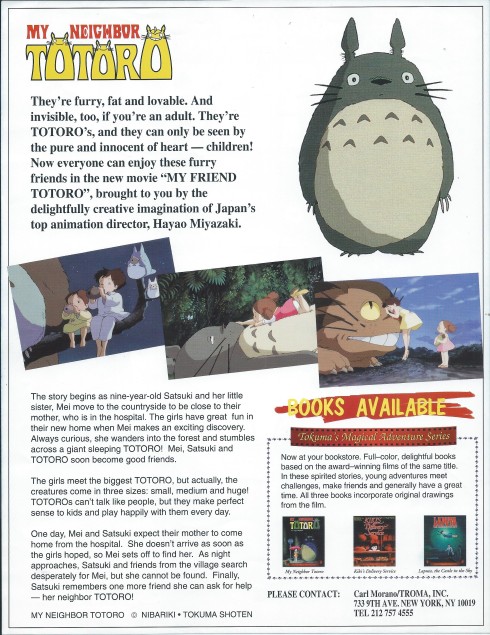
Notice the ads for three books based on Miyazaki’s films, TOTORO, KIKI’S DELIVERY SERVICE and LAPUTA: CASTLE IN THE SKY. The latter two films had not yet been released in the U.S. other than a few repertory showings of LAPUTA.
Here’s the first newspaper ad I saw for TOTORO that week:
TOTORO opened in New York on Friday, May 14, 1993 at a number of area theaters including the Guild 50th St. in Rockefeller Center in midtown Manhattan, a theater which often showed Disney re-releases. I took my daughter to see it there. At one point during the showing she leaned over and asked me how much longer it had to go. Twenty minutes, I told her, and she said, “Shucks!” She wanted it to be longer.
Interestingly, TOTORO wasn’t the first Miyazaki film my daughter and I saw in a theater. It wasn’t even the second. We’d seen LAPUTA: CASTLE IN THE SKY (1986) in an English-dubbed edition four years earlier, in 1989, at the Film Forum, Manhattan’s premier repertory theater, and LUPIN THE 3RD: THE CASTLE OF CAGLIOSTRO (1979), Miyazaki’s first theatrical feature, the previous summer in a Japanese-language print with English subtitles at Cinema Village Third Avenue in Manhattan’s East Village. (When I asked the cashier there about children’s prices I was told that since it was in Japanese with subtitles, there were no children’s prices. I replied indignantly, indicating my then-nine-year-old daughter, “She can read!”)
Getting back to TOTORO’s New York theatrical release, I recently found in a file cabinet drawer a folder of newspaper clippings I’d saved of reviews of the film published upon its opening. Old guard reviewer Joseph Gelmis, writing for Newsday, awarded it a generally positive review, giving it three stars (***). Since I can’t find any suitable pull quotes in it, please click on the review to make it big enough to read:
Stephen Holden, third string reviewer at The New York Times, whose specialty was covering cabaret acts, gave it a mixed review but had this to say:
“[When it] is dispensing enchantment, it can be very charming. The scenes in which the girls have midnight adventures and witness miracles have the yearning dream-like exhilaration of Mary Poppins’ nocturnal adventures with her charges. Too much of the film, however, is taken up with stiff, mechanical chitchat.
“My Neighbor Totoro is visually very handsome. All the action is set in lush Japanese landscapes whose bright blue skies and gorgeous sunsets evoke a paradisiacal garden of earthly delights.”
To my great surprise, the two hippest and youngest reviewers working in New York at the time, the Phantom of the Movies at the Daily News and Jami Bernard at the New York Post, both trashed the film unmercifully. You can read the reviews here:
Well, at least Bernard praises the bus stop scene.
But how wrong the Phantom’s headline would prove to be: “Winged-cat hero won’t fly in U.S.” I wonder if the two reviewers got any backlash from fans at the time or ever revisited the film after its popularity soared in America over the years. (In researching this, I learned the sad news that the Phantom of the Movies passed away in 2020. Aside from this review, I enjoyed his regular column in the Daily News and his magazine VideoScope.)
On a side note, both reviewers also reviewed UROTSUKIDOJI: LEGEND OF THE OVERFIEND a few months earlier that year, in February. Bernard gave it two stars (**) while the Phantom gave it three stars (***).
Variety’s review of TOTORO, by Leonard Klady, was no kinder.
What do you think of that last paragraph calling it “a TV half-hour” padded into “a sluggish feature”?
Fortunately, Roger Ebert championed the film from his perch at the Chicago Sun-Times and on his show, “At the Movies with Siskel & Ebert.”
Here’s an ad from the time with his critical blurb featured prominently at the top.
I can’t locate a link to Ebert’s original Chicago Sun-Times review, but here’s a link to a later review of the film he posted on his website in 2001:
https://www.rogerebert.com/reviews/great-movie-my-neighbor-totoro-1993
Here are the opening and closing paragraphs:
”My Neighbor Totoro” has become one of the most beloved of all family films without ever having been much promoted or advertised. It’s a perennial best seller on video. On the Internet Movie Database, it’s voted the fifth best family film of all time, right behind ”Toy Story 2” and ahead of ”Shrek.” The new Anime Encyclopedia calls it the best Japanese animated film ever made. Whenever I watch it, I smile, and smile, and smile.
….
I’m afraid that in praising the virtues of ”My Neighbor Totoro” I have made it sound merely good for you, but it would never have won its worldwide audience just because of its warm heart. It is also rich with human comedy in the way it observes the two remarkably convincing, lifelike little girls (I speak of their personalities, not their appearance). It is awe-inspiring in the scenes involving the totoro, and enchanting in the scenes with the Cat Bus. It is a little sad, a little scary, a little surprising and a little informative, just like life itself. It depends on a situation instead of a plot, and suggests that the wonder of life and the resources of imagination supply all the adventure you need.
I wrote my first review of TOTORO in 1993 as part of the first group of reviews I did as a freelance writer for the annual Motion Picture Guide. It’s not on-line, but here are scans of the review portions of my entry, leaving out the plot synopsis.
TOTORO was the first anime feature to be shown in theaters in the U.S. outside the arthouse-repertory-college circuit where other anime features (AKIRA, VAMPIRE HUNTER D, et al) had played and where I’d seen them. When I consulted my collection of books on anime in researching this piece, I found this passage in Fred Patten’s book, Watching Anime, Reading Manga: 25 Years of Essays and Reviews, which briefly addresses TOTORO’s release in the context of other anime feature releases in the U.S. at the time: “The only exception [to ‘fine-art theatrical circuit’] was Troma’s 1993 small general release of the family film, My Neighbor Totoro. It was not successful enough to justify the costs of making dozens of 35 mm prints and taking out full-page newspaper advertising.”
Curiously, the English dub had actually been made in 1988 when Carl Macek and Streamline Pictures had been commissioned to provide a dub of the film for Japan Airlines. According to Anime News Network:
The original English Dub was produced by Streamline Pictures for Japan Airlines transpacific flights in 1988. This version was then distributed theatrically in North America in 1993 by Troma and released on VHS and DVD by Fox. The Troma/Fox releases never included Japanese audio as Troma did not have any rights for the original Japanese Audio.
Macek’s credit on the film reads “Produced and Adapted by Carl Macek.” Gregory Snegoff is listed as writer and director of the English dub. Macek’s Streamline Pictures was an early distributor of anime in the U.S., both on home video and theatrically, with such titles as AKIRA, ROBOT CARNIVAL, NEO-TOKYO, LENSMAN, SILENT MOBIUS and THE PROFESSIONAL: GOLGO 13 coming out from the company. (The early Streamline VHS releases in my collection all seem to be English dubs.)
My question, of course, is why Macek and Streamline did not distribute MY NEIGHBOR TOTORO in the U.S. since they’d already had good runs with AKIRA and some of the other anime features. And how did Troma get involved? I emailed these questions to an animation historian who was involved with Streamline and is credited on the TOTORO English dub, but have not yet gotten a response. So why was Troma awarded the right to distribute TOTORO theatrically in the U.S.? Helen McCarthy in her book on Miyazaki, Hayao Miyazaki: Master of Japanese Animation, says it was Tokuma, the Japanese publishing giant that funded the production of TOTORO, that made the deal with Troma and not Miyazaki’s company, Studio Ghibli. My educated guess is that Troma had a larger distribution network than Streamline and could promise Tokuma a wider reach beyond the festival circuit for a family film that might not click with the same audiences who clamored for AKIRA. In fact, Troma sent it out to 41 theaters in the greater New York area alone, as indicated in this newspaper ad listing theaters where it was playing in New York, Long Island, upstate counties and New Jersey:
I don’t believe Streamline could have arranged that.
In 1994, Fox Home Video released MY NEIGHBOR TOTORO on VHS and achieved instant success, selling hundreds of thousands of units, making it a home video best-seller that year, with sales continuing over the years as word of mouth spread and Hayao Miyazaki’s reputation in the U.S. began to grow. Of course, I bought a copy and my daughter and I watched it multiple times over the years. I even bought a second copy to keep on the shelf at my office and lend to co-workers with small children and their response was invariably one of enjoying it just as much as their kids did.
In 1996, the Walt Disney Company announced a record-breaking deal with Studio Ghibli to distribute Ghibli films worldwide outside of Japan. In 1998, the first film released on VHS under this agreement was Miyazaki’s KIKI’S DELIVERY SERVICE (1989), the film he’d completed a year after TOTORO. It came with a new English dub voiced by well-known Hollywood actors, including Kirsten Dunst as Kiki, Phil Hartman as her talking cat, Jiji, Janeane Garofalo as Ursula, and Debbie Reynolds as Madame.
Disney also released a Japanese-language edition with English subtitles on VHS. They apparently listened to the fans!
I had long thought that TOTORO was the only Miyazaki film to get a legitimate home video release in the U.S. prior to the Disney deal. Not so. In 1985, Roger Corman’s New World Pictures had distributed to theaters a film called WARRIORS OF THE WIND, a severely cut, English-dubbed version of Miyazaki’s 1984 film, NAUSICAA OF THE VALLEY OF THE WIND. This was released by New World Video on VHS the same year. It played at the Film Forum in New York in 1987 as part of their annual Summer Festival of Fantasy & Science Fiction. I was unaware of the significance of it at the time or I would have gone to see it. Here’s the schedule page for it:
The WARRIORS VHS cover offered a rather misleading impession of the film:
Here’s a key image from the original film:
For the longest time I only had the untranslated Japanese-language VHS copy of TOTORO and Fox Video’s English dub, when I most wanted a VHS copy in Japanese with English subtitles. According to my records, I didn’t find one until 2000 when I bought a fan-sub off a dealer at a comics show. (In fact, my very first untranslated copy of the film was acquired the same way, but from a different dealer’s table.) I re-watched the fan-sub for this piece and was surprised to see how many Japanese words were left intact in the subtitles, including “Itadakimasu!” (Let’s eat!) and “susu-atari,” Granny’s word for the “soot balls of fluff” which seem so sentient when Satsuki and Mei first encounter them. They’re called “dust bunnies” in the Fox dub, which has always made the most sense to me, and alternately “soot gremlins” and “soot sprites” in the Disney dub.
Cutting ahead to the early 21st century, Fox’s home video rights to TOTORO were due to expire, so in 2002 they released their English dub of MY NEIGHBOR TOTORO on DVD, very successfully I might add, and I made sure to buy a copy. (As of this writing, it’s still in print and sells for $24.95 per copy on Amazon.)
For the record, I watched the Fox DVD with the original English dub of TOTORO again for this piece and was greatly impressed by the quality of the voice acting, not something I say about many English dubs of anime. I think it holds up very well.
In 2006, ten years after Disney made the deal with Studio Ghibli, they finally got around to releasing TOTORO on DVD with a new dub (made in 2004) featuring celebrity actors, including the child actor sister team of Dakota Fanning and Elle Fanning as the two sisters in the film, Satsuki and Mei. Timothy Daly and Lea Salonga do the voices of the parents, while Pat Carroll plays Granny. A Blu-ray came later.
I re-watched the Disney dub for this piece and while the adults are fine and the sisters do an okay job, I find the kids lacking in the big emotional scenes. Whether they were directed this way or not, they came off as too low-key for me. The problem is that the best voice-acting of child characters is done by adult actors who can do child voices but also capture the nuances of a child’s reactions to emotional situations. Child actors may sound more like children, as the Fanning sisters do, but they don’t quite grasp the complexity of the characterizations. In TOTORO, Satsuki has to negotiate with different levels of adults–her father, Granny, her teacher–as well as with Totoro, when she pleads with him for help in finding the lost Mei, all while expressing exasperation with the impetuous Mei. The English dub actresses in the original, Lisa Michaelson and Cheryl Chase, got it right. Japanese actresses do this even better.
In any event, the original Japanese voice cast of TOTORO is still the best option. Noriko Hidaka plays Satsuki and was 25 or 26 when she did the part. You could have fooled me! She sounds just like a nine-year-old girl going through the turbulence Satsuki goes through in the film.
Hidaka was a special guest at the Animazement anime convention held over the recent Memorial Day weekend (2024) in Raleigh, North Carolina. A friend of mine went and got to meet her and get her signature on various Totoro-related items. In a 40-year career, Hidaka is also known for the voices of Akane Tendou in “Ranma ½,” Noriko Takaya in “Gunbuster,” Sojiro in “Rurouni Kenshin” and Kikyo in “Inuyasha,” among many other roles.
A YouTube channel called The Rerun Lounge did a half-hour video discussion of the merits of TOTORO’s original English dub vs. the Disney dub. It’s called “Totoro vs Totoro! A Look at the Streamline and Disney Dubs!” and the author clearly prizes the earlier dub, although he points out that the Disney dub gets a few things right, including the correct pronunciation of Satsuki’s name. It’s “SAT-ski,” as opposed to “Sat-SU-ki.” (The latter, of course, is how I’ve been pronouncing it all these years–gulp!). Here’s the link, cued to the 10-minute mark when the actual discussion of the dubs begins.
He also points out the differences between the singer who did the opening and closing songs in the original English dub, Cassie Byram, and the one who did them in the Disney dub, Sonya Isaacs. The English lyrics from the original, written by Severin Browne, are used in both dubs. Like the host of the Rerun Lounge, I prefer Ms. Byram’s renditions. They’re simpler, more direct and the lyrics are easier to understand.
I devoted significant space to TOTORO in my entry for the film in the book I co-wrote with Animerica editor Julie Davis, Anime Classics Zettai: 100 Must-See Japanese Animation Masterpieces (Stone Bridge Press, 2007).
Finally, one last memory of the intricate career-long bond of Miyazaki and Totoro. In 1999, when Miyazaki was in New York to promote PRINCESS MONONOKE’s premiere at the New York Film Festival (see my previous entry on the subject, Hayao Miyazaki in New York: The Lost Interview 1999), a retrospective of Ghibli films was shown at the Museum of Modern Art. I was there for the screening of TOTORO and I knew something was up when I saw Miyazaki and his entourage in the reception area outside the auditorium. I had interviewed him two days earlier and both his interpreter, Linda Hoaglund, and his producer, Toshio Suzuki, saw me when I went over and greeted me warmly. The audience had no idea he was there and when the film department co-chief, Larry Kardish, introduced Miyazaki to the unsuspecting crowd they went completely wild, as you can imagine, and after a long standing ovation (punctuated by cries of “I can’t believe it!), finally took their seats to hear his remarks. I took this surprise appearance as a signal that this was the director’s own personal favorite of all of his films.
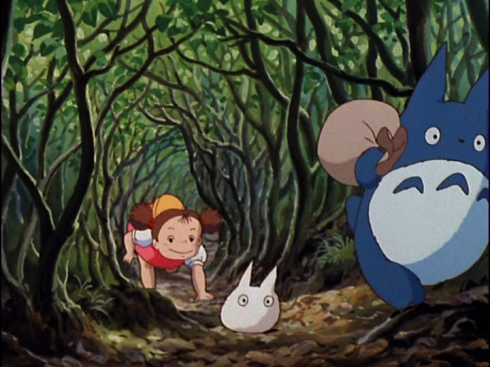


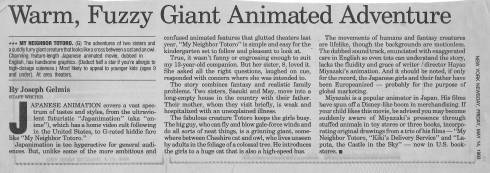
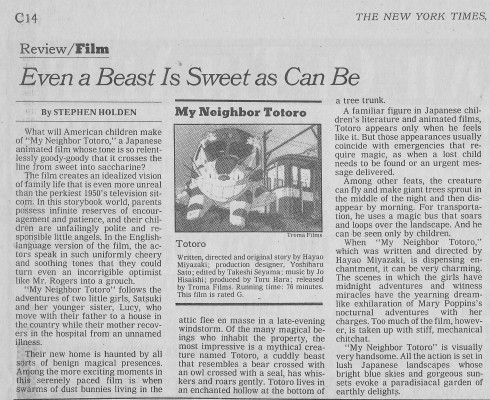





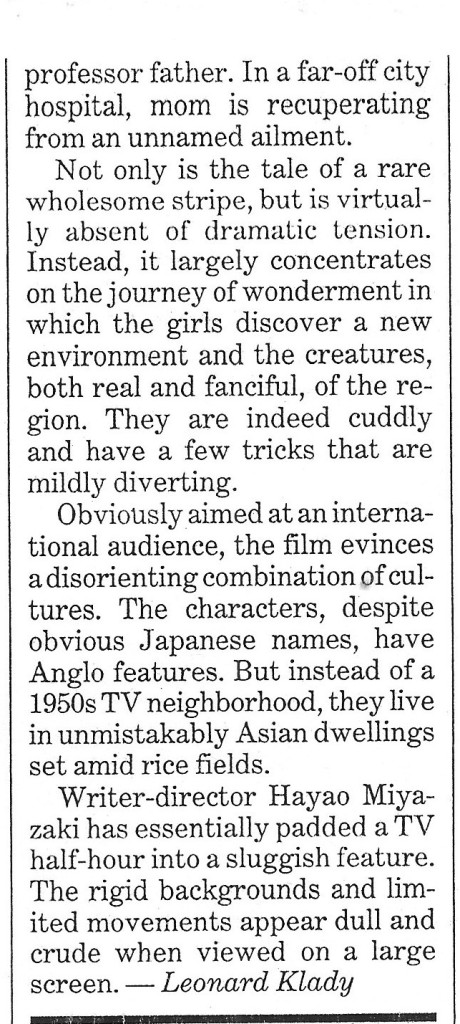
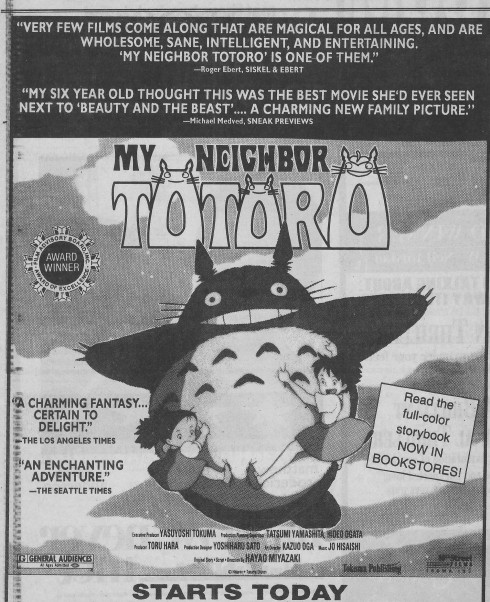

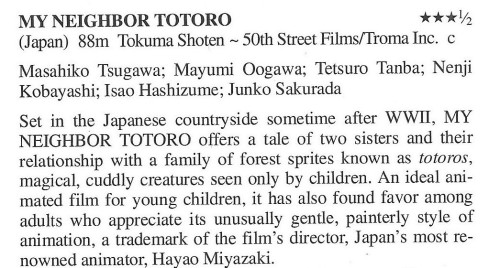
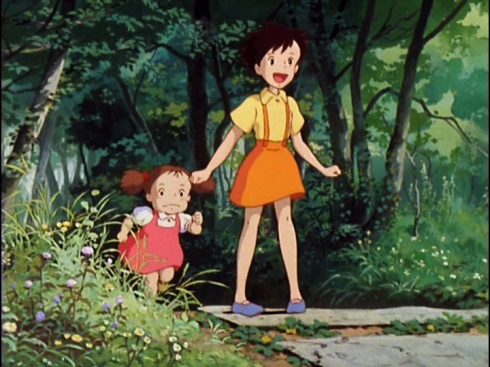

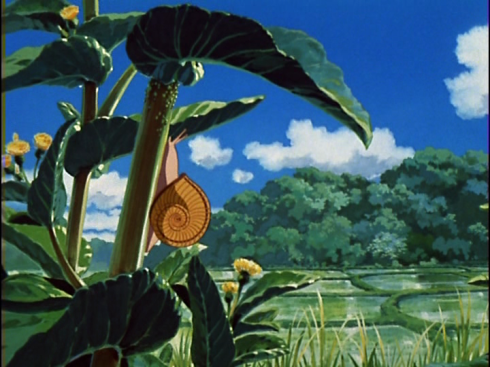

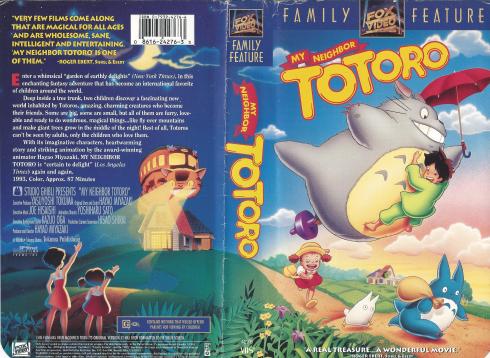

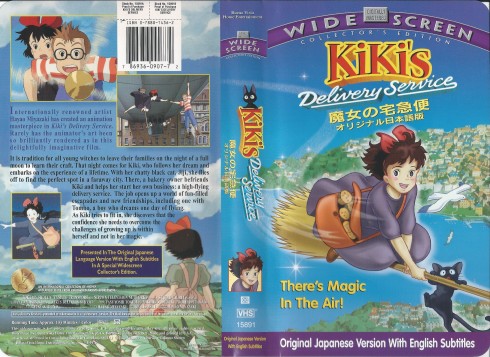
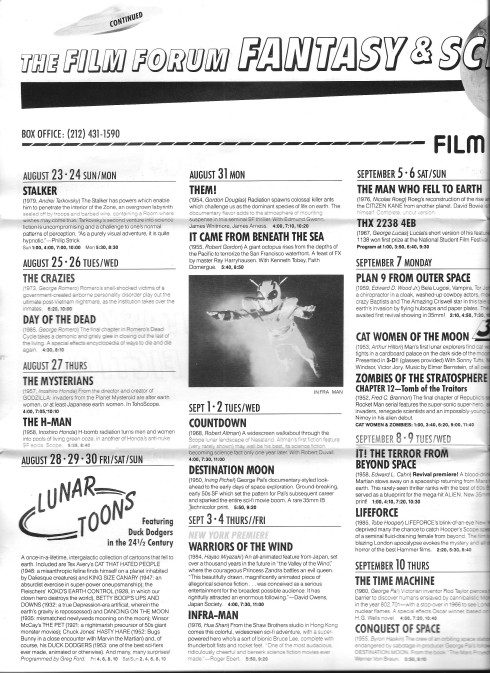

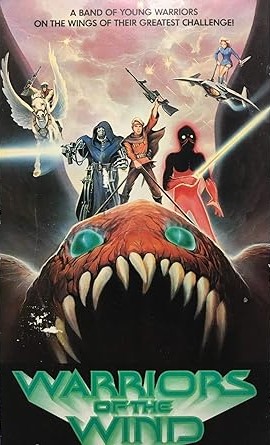
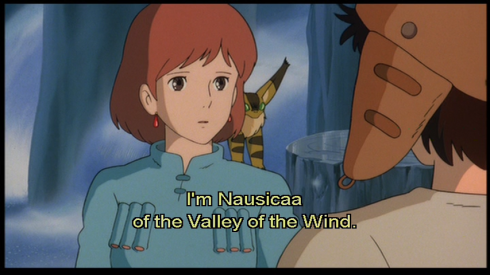

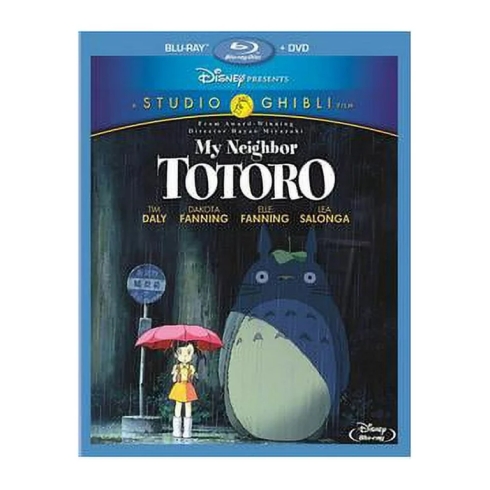

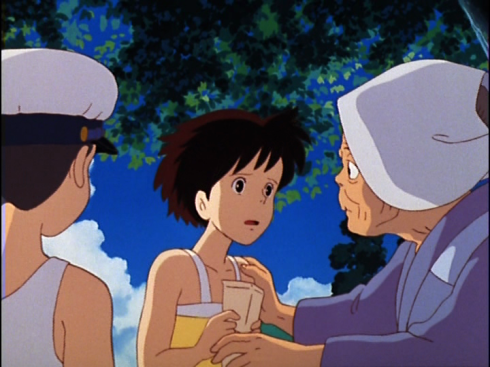



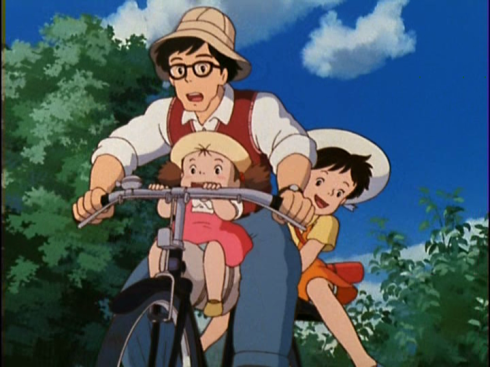
Bravo, Brian!